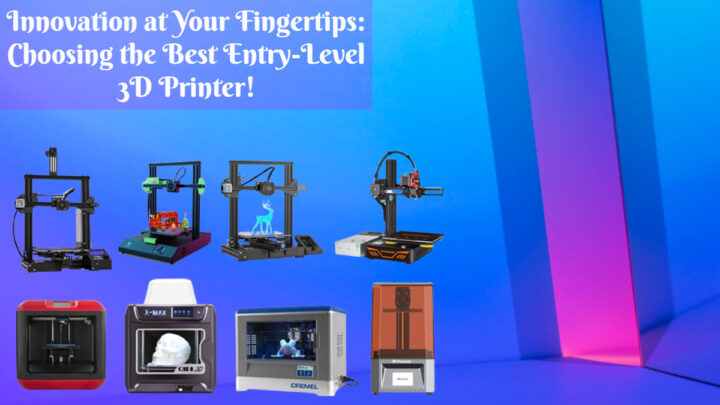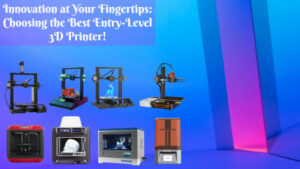Embarking on the exciting journey into the world of 3D printing opens up boundless possibilities for emerging creators and visionaries. As the once futuristic concept transforms into an accessible reality, the challenge lies in guiding the various options to select the perfect entry-level 3D printer. This guide acts as your guiding light through the digital, ensuring you unlock your creative potential and bring your ideas to life, one layer at a time.
The initial required consideration is understanding your creative arena. Filament-based printers offer a rich material spectrum, while resin printers boast intricate detail. Aligning the technology with your environment and project aspirations is paramount. Strategic budgeting follows, with entry-level printers spanning from sub-$200 kits to approximately $500 for pre-assembled options. It’s crucial to factor in supplementary costs like filament, software, and potential upgrades.
Usability emerges as the unsung hero, with user-friendly features such as intuitive touchscreen interfaces, Wi-Fi connectivity, and beginner-friendly software smoothing the learning curve. Recognizing the significance of community support in the 3D printing world is vital. By tapping into online forums, YouTube tutorials, and local maker spaces, you gain troubleshooting tips, project inspiration, and a supportive network to navigate occasional hiccups. With careful consideration and research, the ideal entry-level 3D printer awaits, ready to transform your most imaginative ideas into tangible realities, placing the future of innovation within your reach, one printed layer at a time.
What you will see here?
Sovol SV06
The Sovol SV06 emerges as an impressive 3D printing device designed for both newcomers and seasoned enthusiasts, featuring a traditional I3 configuration equipped with linear rails to enhance durability. At its core lies the revolutionary all-metal planetary dual-gear direct drive extruder, ensuring precise filament feeding and supporting a wide variety of materials through its high-temperature all-metal hot end capable of reaching 300°C. User-friendly attributes encompass a 25-point automatic bed leveling system, a flexible PEI build plate, and a 32-bit silent motherboard, establishing it as a quiet and user-friendly addition to any workspace. Boasting a potential print speed of 250mm/s (in conjunction with the separately sold Sovol Klipper screen), speed enthusiasts will find its efficiency commendable. The printer's completely open-source nature facilitates customization and upgrades, while its modular design streamlines assembly, appealing to beginners.
In summary, the Sovol SV06 excels in performance, ease of use, and cost-effectiveness, positioning itself as an optimal choice for both novices and seasoned creators alike.
The Sovol SV06 serves as an entry-level 3D printer with a budget-friendly price, making it ideal for new hobbyists. While lacking some advanced features of pricier models, its focus on user-friendliness with auto-bed leveling and quiet operation simplifies learning. It excels with PLA but may need adjustments for other filaments. Upgrade potential is limited, but it offers solid printing performance for beginners.
Anycubic Kobra Plus
The Anycubic Kobra Plus 3D Printing machine distinguishes itself as a versatile and easily navigable large-scale printing answer, featuring an impressive construction size of 350 x 300 x 350mm. Serving the needs of novices and experienced aficionados alike, its 25-point automated leveling mechanism guarantees meticulous bed alignment, ensuring proficient adherence during the printing process. The all-metal geared extruder enhances durability and reduces filament jams. Dual Z-axis leadscrews facilitate seamless bed movement, elevating print quality.
The heated tempered glass bed mitigates warping risks, and a 4.3-inch touchscreen simplifies control. Filament run-out detection and power-off resume enhance reliability. Capable of handling diverse filaments such as PLA, ABS, TPU, and PETG, it showcases adaptability. Noteworthy in terms of cost-effectiveness, it emerges as an appealing option for users mindful of their budget. Consideration of size and weight is crucial for seamless installation.
The absence of a heated print bed may limit compatibility with certain filaments like ABS, and the lack of an enclosure requires precaution for fumes. In summary, the Anycubic Kobra Plus excels in large-format 3D printing, offering cost-effectiveness and user-friendliness for diverse expertise levels.
Priced at around $428*, the Anycubic Kobra Plus qualifies as an entry-level 3D printer, catering to beginners with features like automatic bed leveling and a user-friendly interface. While lacking advanced functionalities, its affordability and ease of use make it suitable for hobbyists and educators, though experienced users may find its limitations restricting.
Creality Ender 3 V2
The Creality Ender 3 V2 stands out as a balanced choice. With dimensions measuring 475 x 470 x 620mm and a generous 220 x 220 x 250mm printing capacity, it effortlessly accommodates an array of imaginative projects robust aluminum framework and pre-fitted elements guarantee a steadfast base, simplifying the initialization process for those new to the craft.
Notably, the hushed motherboard reduces operational noise, contributing to a more pleasant working environment. The UL-certified power supply enhances safety. Filament handling becomes a breeze with the rotary knob on the extruder, and the carborundum glass platform ensures excellent adhesion for flawless prints. The printer's resume function safeguards against power interruptions, saving time and filament.
The enhanced 4.3-inch color touchscreen elevates the user interface, rendering control and monitoring an intuitive experience. Whether you possess seasoned expertise or are just stepping into the realm of 3D printing, the Creality Ender 3 V2 presents a captivating printing journey at an appealing cost, empowering you to effortlessly breathe life into your creative concepts.
The Creality Ender 3 V2 claims its entry-level throne through a perfect mix of affordability, user-friendliness, and capability. Priced below $300, it's a budget-friendly choice for beginners, with a straightforward setup and reliable printing performance. While lacking advanced features, its open-source nature allows for extensive customization, making it an ideal gateway to the diverse realm of 3D printing.
ELEGOO Neptune 4 Pro
The ELEGOO Neptune 4 Pro 3D Printer, priced at $359*, offers a budget-friendly option with user-friendly features and versatile connectivity. Compact at 17.5 inches deep, 18.7 inches wide, and 20.3 inches tall, weighing only 19.6 pounds, its lightweight aluminum construction enhances portability. Compatible with PCs, phones, and laptops, users enjoy flexible device options. Boasting 121 points of auto bed leveling for fast and precise calibration, the printer incorporates a 300°C high-temperature nozzle and an extended hot end for efficient filament handling. With a remarkable print speed of 500mm/s, facilitated by Klipper firmware and a powerful processor, it provides the flexibility to choose between ultra-fast or slightly slower printing. Upgraded X and Y axes with all-metal guide rails enhance durability, while segmented heated zones and a dual-gear direct drive extruder contribute to efficient and reliable 3D printing.
The ELEGOO Neptune 4 Pro is an entry-level 3D printer, priced affordably for beginner hobbyists. With easy assembly, auto-bed leveling, and intuitive controls, it caters to users with minimal 3D printing experience. While lacking advanced features of higher-end models, it provides decent print quality, a large build volume, and fast printing speeds. The Neptune 4 Pro serves as a bridge between basic and professional machines, offering a balanced mix of affordability, user-friendliness, and printing capabilities for first-time enthusiasts.
FDM Mini 3D PrinterÂ
The phrase "Compact 3D Printer using Fused Deposition Modeling (FDM)" encompasses a spectrum of petite 3D printing devices meticulously crafted for user convenience and efficient use of space. Although there may be variations in specific details among the models, they generally exhibit shared attributes. Manufactured by diverse companies, these printers specifically target novices and individuals with limited workspace.
Distinguished by a smaller print volume in contrast to their larger counterparts, FDM Mini 3D Printers excel in producing diminutive items such as trinkets, keychains, and figurines. Recognizable for their budget-friendly nature and straightforward assembly, they act as a welcoming entryway into the realm of 3D printing. These printing devices typically offer support for an array of filaments, including PLA, ABS, and TPU, providing users with a range of material options. Though there could be differences in particular models, brands, and features, the fundamental idea revolves around providing a compact, economically feasible, and user-friendly 3D printing solution. This makes them apt for enthusiasts aiming for an accessible introduction to the technology.
The FDM Mini 3D Printer is an entry-level choice with a small 4x4x4in build volume, basic FDM technology, and simplified features. Geared towards beginners, it emphasizes ease of use with quick assembly, user-friendly software, and affordability, making it an ideal introduction to 3D printing before exploring more advanced and pricier options.
Anycubic Kobra 2 Neo
The Anycubic Kobra 2 Neo 3D Printer, priced at $239*, packs professional-grade capabilities into its compact 5x5x5" and 20 lbs frame. Operating with user-friendly Marlin firmware, it offers reliability with a 1-year warranty and lifetime assistance. Standing out with 5X High-Speed capabilities, it boasts a remarkable 65% reduction in print time compared to standard printers, reaching a Max Print Speed of 250mm/s while balancing precision at the suggested 150mm/s. The Integrated Extruder and LeviQ 2.0 Automatic Leveling system enhance efficiency, featuring an upgraded extrusion system, a powerful 60W hot end, and a high-speed cooling fan. The LeviQ 2.0's Automatic Leveling intelligently compensates for Z-axis offset, allowing customization for various user needs. This pint-sized powerhouse combines speed, accuracy, and innovation for rapid and efficient 3D printing experiences.
The Anycubic Kobra 2 Neo is an entry-level 3D printer, notable for its affordability, user-friendly design with auto-leveling and touch screen interface, and basic features like filament runout sensors. Despite not having advanced capabilities found in pricier models, its balanced approach suits beginners prioritizing ease of use and cost-effectiveness while offering a stepping stone for future exploration.
What features are important for beginners?
When selecting a 3D printer, prioritize ease of assembly and calibration by opting for pre-assembled or semi-assembled options, featuring auto bed leveling and user-friendly interfaces. Ensure reliable performance with consistent print quality, minimal maintenance, and robust community support. For affordability, consider printers compatible with PLA, an easy-to-use and cost-effective filament for beginners. Prioritize safety with an enclosed design, particularly crucial when working with materials like ABS. Together, these standards collaboratively enhance a smooth 3D printing encounter, rendering the procedure approachable and effective for users across all proficiency levels.
Which software is needed for 3D printing?
Effortlessly transform 3D models into printer instructions by employing slicing software such as Cura or PrusaSlicer.For those keen on designing custom models, consider optional 3D modeling software such as Blender or Tinkercad. These tools empower users to create unique designs while slicing software ensures seamless communication between the model and the printer. This combination allows both beginners and advanced users to enjoy a comprehensive 3D printing experience, from designing original models to executing precise prints with ease.
ConclusionÂ
Navigating the landscape of entry-level 3D printers unveils a multitude of opportunities for unleashing innovation within arm’s reach. Choosing the perfect entry-level 3D printer extends beyond mere cost-effectiveness. It entails identifying the apparatus that aligns with your specific needs and ambitions. Whether you’re an enthusiast, a learner, or a budding innovator. A fitting 3D printer has the potential to catalyze nurturing imagination and facilitate experimentation. Taking into account elements such as printing precision, and a user-friendly interface. The spectrum of available features enables you to arrive at an enlightened choice, propelling your projects to unprecedented pinnacles.
Welcome the inherent potential of 3D printing technology and set forth on a voyage where innovation evolves from a conceptual idea into a tangible and accessible reality. The capability to give life to your ideas is now firmly within your grasp, and the spectrum of possibilities with the appropriate 3D printer is limitless.






















